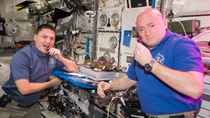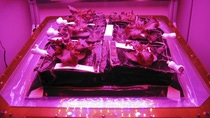Media
Houston, we have vegetables growing in space
BASF supplies special fertilizer coating ingredients that allow NASA to grow plants in orbit, and beyond.

Salads are a delicacy hard to come by in space, but one that astronauts covet. And now two companies have made this dream of growing fresh vegetables in space a reality.
BASF, in conjunction with fertilizer manufacturer Florikan, has found a solution to the most common dilemma facing fertilizers today—and it’s changing the world of agriculture.
The biggest problem with fertilizers worldwide is that they release too fast and go into the groundwater instead of going straight to the plant.
Florikan and NASA saw the value of BASF's chemistry that coats the fertilizer, which specifically matched with Florikan’s technology. As a result of this coating, the fertilizer's release is controlled, providing the right number of nutrients going straight to the plant instead of into the air or being absorbed by the water.
“You have people up in space, some for 12 months or more at a time, eating dehydrated powdered food and nutrition to stay alive. Now, through use of this technology, you can grow plants without soil,” said Gary Lambert, National Accounts Manager, Monomers North America, BASF, in an interview.
The fertilizer is called FlorikanCRF, created by Florikan, a Sarasota, Florida-based company, which is coated with polymers from BASF that control when and how much of each ingredient—macronutrients such as nitrogen, phosphate and potassium, and micronutrients such as magnesium and zinc—is released over six months to a year. (FlorikanCRF is currently manufactured under license to use as GalXEone by J.R. Simplot Co.)
The BASF proprietary products contributing to this result are customized with Pluracol polyols and other additives. These ingredients form a semi-permeable coating that controls the release rate of Nitrogen via osmosis and reduces environmental loss. And thanks to its unique capability, plants can now, for the first time, be grown in space.
“These polymers control the release of the fertilizer,” Ed Rosenthal, Florikan Founder, told BASF in an interview, “and we can greatly reduce pollution into water if we use this technology, that’s what BASF has created.”
Florikan and BASF formed a partnership in 2012, when the former started buying the BASF products directly in bulk for its coated fertilizer. This new coating helped increase Florikan’s customers base, from 6,000 tons to 30,000 tons in sales. Shortly after, Rosenthal got an email from NASA asking him for help in growing vegetables on ISS (International Space Station).
Instead of using soil, which is not allowed in space, NASA used a porous, baked-clay substrate. The clay holds the roots and the water in place, but it doesn’t provide any nutrition to the plants, that all comes from the fertilizer, according to a NASA release.
“NASA vetted all other technologies around the world. All other products have been tested and they selected ours to grow vegetables in space. No other product succeeded,” Rosenthal said. “The polymer is so flexible that we’re able to use it with all these nutrients that are control released. It is extremely valuable in agriculture because we can control the release of nutrients for 180 days or longer.”
The NASA crew, called Space Plant Biology, of which Rosenthal is a member, has so far grown three crops of Red Romaine Outredgeous lettuce, thanks to FlorikanCRF (containing Nutricote). The crew continues to research how to optimize the fertilizer for different plant types, including modifying the ingredients and release rates and examining how different fertilizers impact the nutrient content of the harvest.

Meanwhile, in April, The Space Foundation inducted Florikan SNR controlled-release fertilizer together with NASA Kennedy Space Center and NASA-funded Space Alliance Technology Outreach Program into the 2017 Space Technology Hall of Fame for “outstanding example of applying space technology for the betterment of life on Earth.”
While being able to grow plants in space is a giant step for man, this innovation goes far beyond that.
The current world population is estimated to increase by 1 billion over the next 12 years and reach 9.6 billion by 2050, according to a 2013 United Nations report. And yet, there is no more land to grow plants, forcing us to get more yield out of existing acreage that’s growing plants today.
“We have a solution here that can help feed the increasing population of the world, allowing us to grow more crops on existing soil, and at the same time protecting our environment,” Lambert added.
“And if you can grow plants in a space station, with no microgravity, no light and no soil, you can grow it anywhere, even on Mars,” Rosenthal concluded.
Published by Anna Spiewak.
For media inquiries or to repurpose this article, please contact Lisa Brown.